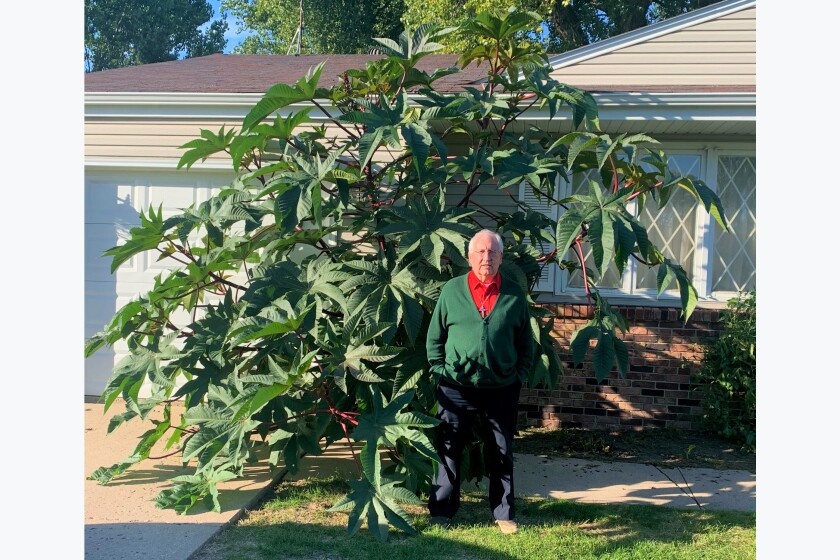Q: I listen to you on the radio and enjoy it very much. I thought you’d be interested in this picture of my dad, Ed Tupa’s, castor bean plant. — Mike Tupa.
A: Thanks, Mike, for the great photo of a fascinating plant, and congratulations, Ed, on growing the castor bean to a size that’s more gigantic than average. Mike continues, “The real credit should go to my wife. She’s the one that starts them in early spring from seed collected the previous year.
“This year my dad’s plant was 12 feet high and 14 feet wide and the circumference of the trunk base was about 6 inches in diameter. Some leaves were 3 feet by 3 feet or larger. I’m guessing this year’s heat, sun and humidity were the key and he had plenty of water where he planted it.”
Castor bean plants are native to tropical Africa, where it can become a tree 40 feet high. It’s easily killed by frost at 32 degrees Fahrenheit, but in climates like ours, it makes a delightful tropical-looking addition to the background of a summer flower bed or tucked in a landscape.
Castor bean plants are best started indoors about April 1 for transplanting outdoors after danger of frost is passed. Seed is available from mail-order companies such as Gurney’s. The plants grow rapidly, reaching an average height of about 6 feet high and wide in the Upper Midwest during the growing season, until killed by frost.
ADVERTISEMENT
Castor bean seeds are poisonous, but it’s relatively easy to safely prevent the plants from producing any seed by pruning off withered flowers before seed pods develop. To save a few seeds for future planting, securely tie a few developing pods in a plastic bag in an obscure part of the plant.

Q: I enjoyed your recent article on Dexter Perkins' prairie grass yard . Did he mention how he cares for it before winter hits? Does he leave it as is, or does he cut it back as is done for most perennials? — Carolyn W.
A: I presented your question to Mr. Perkins, since fall care wasn’t addressed when we visited about his prairie-type landscape, and he provided the following:
“We mow once a year. We go to the Rentall and get a heavy-duty bush mower and mulcher. To promote flowers, we mow in the late fall after everything goes dormant. If we wanted to promote grasses, we would mow in spring. I have talked with folks who do that every once in a while, to rejuvenate the grasses if some of the flowers seem to be taking over too much.”
RELATED COLUMNS:
Q: We didn’t water our lawn this summer, and it turned brown and went dormant. This fall most of the grass has come back nicely, but there are some bare spots. I sprinkled some grass seed about three weeks ago after raking the areas, but nothing is happening. Did I buy bad seed? — Tom M.
ADVERTISEMENT
A: If you purchased the seed this fall, it was most likely fine. Grass seed labels indicate the date on which germination was tested, and most garden centers and national chains reliably sell seed packaged for the current planting year. If the seed was your own leftover that had been stored in a hot garage for the past three summers, then viability might be a problem.
Lack of consistent surface moisture is the most common cause of failure when seeding grass. To be successful, it’s often necessary to water the seedbed twice a day, sometimes more. If seeding on bare soil, the surface should be kept dark-moist at all times until grass is highly visible. If seeding into existing lawn stubble, the surface should be kept equally as moist.
Because the mid-September window for fall grass establishment is past, you might consider dormant seeding, which means the seed is sown as late in fall as possible, but before lasting winter snows arrive.
If you have a gardening or lawn care question, email Don Kinzler, NDSU Extension-Cass County, at donald.kinzler@ndsu.edu. Questions with broad appeal may be published, so please include your name, city and state for appropriate advice.










